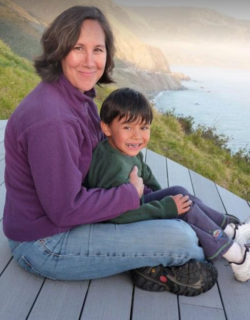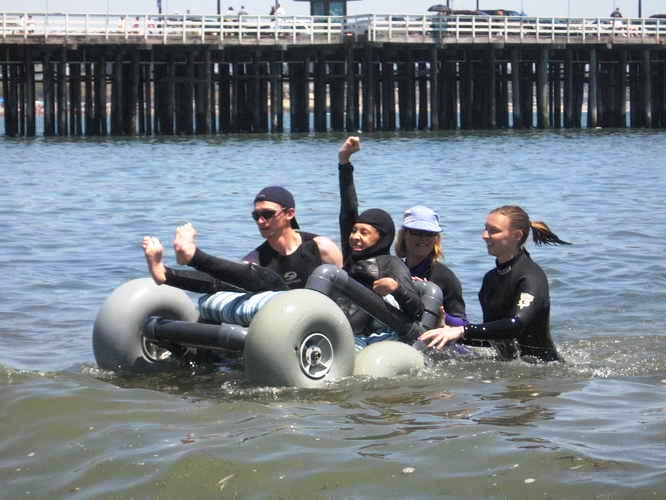
Sanctuary 30th Anniversary Series – Blog #14 “Finding sanctuary: Where will future take us?” by Lisa Wooninck
In the previous two columns, I shared where we’ve been the past 30 years by recounting a few of the successes Monterey Bay National Marine Sanctuary has achieved with partners to protect the productivity and food source that attracts much of the wildlife that migrates here annually. I’ve also shared the innovative partnership we have with the agricultural community to improve water quality of the sanctuary and some of the exciting deep sea discoveries at Davidson Seamount.
These stories only scratch the surface of the many accomplishments achieved with our countless volunteers and partners since 1992. On Sept. 18, we celebrated our 30th anniversary and the National Marine Sanctuary System will celebrate our 50th anniversary on Oct. 23.
Expanding our reach and connecting more with diverse audiences is where we are headed in the next 30 to 50 years.
Connect better
People connect to the ocean for different reasons. For ocean enthusiasts we are their favorite place to recreate (in a sustainable way), such as surfing, fishing, or a contemplative dog walk on the beach (my favorite lately). For ocean conservationists we are the protectors of the ocean from harmful oil and gas drilling.
For marine scientists we are natural laboratories for research to enhance our understanding of the oceans and inform management decisions. For some ocean users our efforts to sustain a healthy ecosystem is in support of their commercial enterprise. We mean many different things to many communities. To help our sanctuaries thrive now and into the future though, we must expand our connection to a more diverse audience representative of the diversity in our communities and the nation.
A new stewardship
Ensuring that people of all backgrounds have the opportunity to experience national marine sanctuaries — especially youth — reinforces the creation of the next generation of ocean users and stewards. We are proud that the Sanctuary Exploration Center Manager Chelsea Prindle, in partnership with the Monterey Bay National Marine Sanctuary Foundation (our friend’s group and nonprofit) recently secured a $300,000/4 year grant from the State Parks’ Outdoor Equity Program.
The grant aims to connect with the Watsonville community by offering in-class programs and field trips to the Sanctuary Exploration Center for fourth graders and fifth graders; paid internships to community college students; and bilingual community programming. Offering opportunities for participants to engage in programs through multigenerational learning will strengthen the impact to this community in the heart of our sanctuary.
Consider joining
We also need to increase diversity on our Monterey Bay National Marine Sanctuary Advisory Council by making participation more accessible and by broadening our recruitment efforts to reach new audiences. I eagerly await recommendations from the Advisory Council at our Oct. 21 council meeting on practical strategies to increase our reach to new audiences that include underrepresented perspectives.
In the next 12 months we will be recruiting for a sizable number of member seats; please consider applying to be a member of the Advisory Council, or encourage a friend to do so. For information on the current need and process, visit montereybay.noaa.gov. We’re accepting applications for the current round of seats through Oct. 24.
Increasing access
As part of our 30th celebration we for the first time partnered with the Santa Cruz based Shared Adventures for their annual Day on the Beach. This inclusive volunteer driven event offers adaptive sports, e.g., kayaking, scuba diving, and beach wheelchair rides to people with disabilities.
Monterey Bay Sanctuary’s educator Lisa Uttal, Advisory Council members Jose Montes and Adam Helm, and our partners at California Fish and Game expanded the adaptive sports opportunities by offering recreational fishing from the Santa Cruz Wharf. We are committed to reaching underrepresented audiences and expanding access. These are the early examples of putting action behind our need to expand diversity, equity, inclusion, justice, and access. More to come.
Explore, experience
I’d be remiss if I didn’t highlight an existing and premier way we connect with various audiences: our visitor centers. You can immerse yourself in the sanctuary without getting wet by visiting our two visitor centers: the Coastal Discovery Center in San Simeon and the Sanctuary Exploration Center in Santa Cruz.
To connect more and promote responsible stewardship of our incredible sanctuary we aim to via engaging and interactive programming at our visitor centers, spark action for marine conservation. The visitor centers are free and once again open to the public after the COVID closures. To learn about the many and diverse sanctuary activities, programs, and volunteer opportunities, visit montereybay.noaa.gov.
To support your national marine sanctuary, also consider checking out our friends group, the Monterey Bay National Marine Sanctuary Foundation at https://montereybayfoundation.org/.
 Monterey Bay National Marine Sanctuary Superintendent Dr. Lisa Wooninck began as a research fishery biologist at NOAA Fisheries headquarters and the Santa Cruz lab, joined the sanctuary as a policy analyst, and then the West Coast Regional team in 2010 as the policy coordinator. She has a Ph.D. in ecology and evolutionary biology from UC Santa Barbara.
Monterey Bay National Marine Sanctuary Superintendent Dr. Lisa Wooninck began as a research fishery biologist at NOAA Fisheries headquarters and the Santa Cruz lab, joined the sanctuary as a policy analyst, and then the West Coast Regional team in 2010 as the policy coordinator. She has a Ph.D. in ecology and evolutionary biology from UC Santa Barbara.
About this series
Monterey Bay National Marine Sanctuary is celebrating its 30th anniversary, and the national sanctuary system its 50th anniversary. In recognition of these milestones, the Sentinel has been publishing columns by former U.S. Secretary of Defense Leon Panetta, former U.S. Rep. Sam Farr, former Save Our Shores Director Dan Haifley, and former California Assemblymember Fred Keeley, who serve on the board of Monterey Bay National Marine Sanctuary Foundation and were involved with the sanctuary’s designation, as well as Sanctuary Superintendent Dr. Lisa Wooninck. For information, visit montereybayfoundation.org or montereybay.noaa.gov.

Students review a water sample to ocean water colors. (Alicia Telfer Photography)

